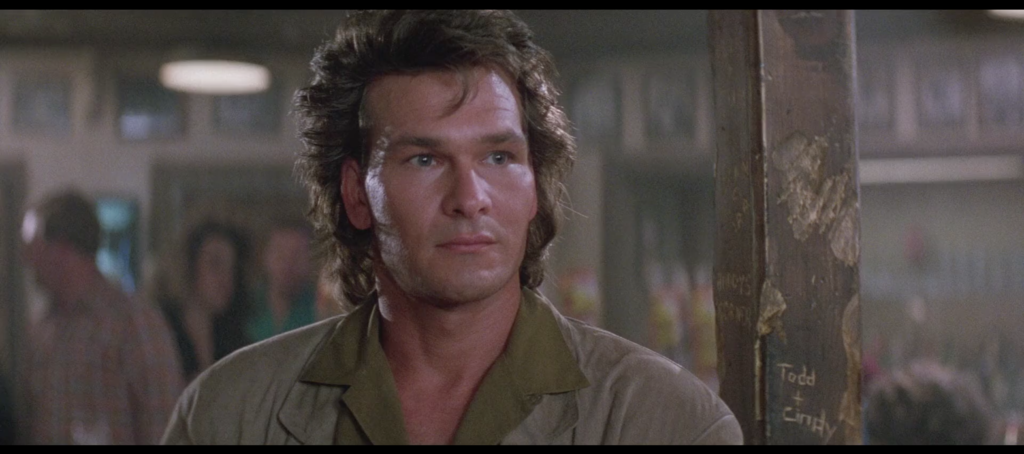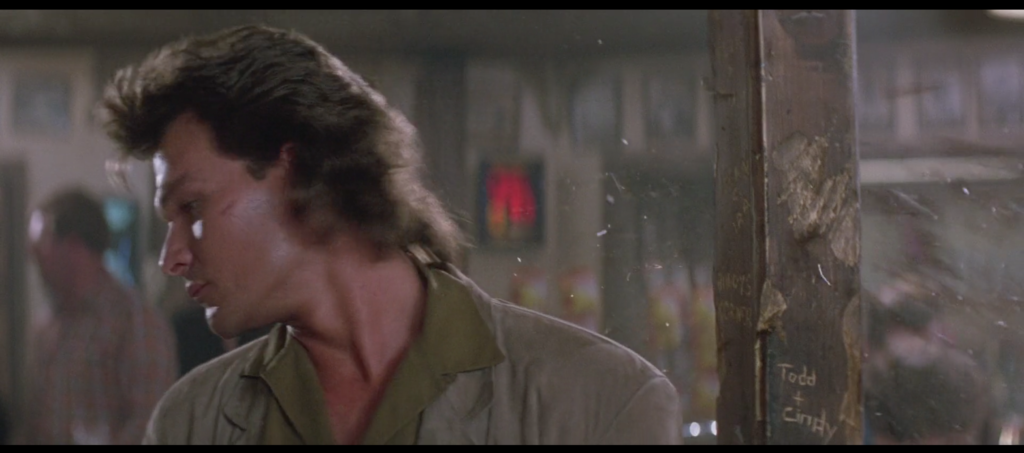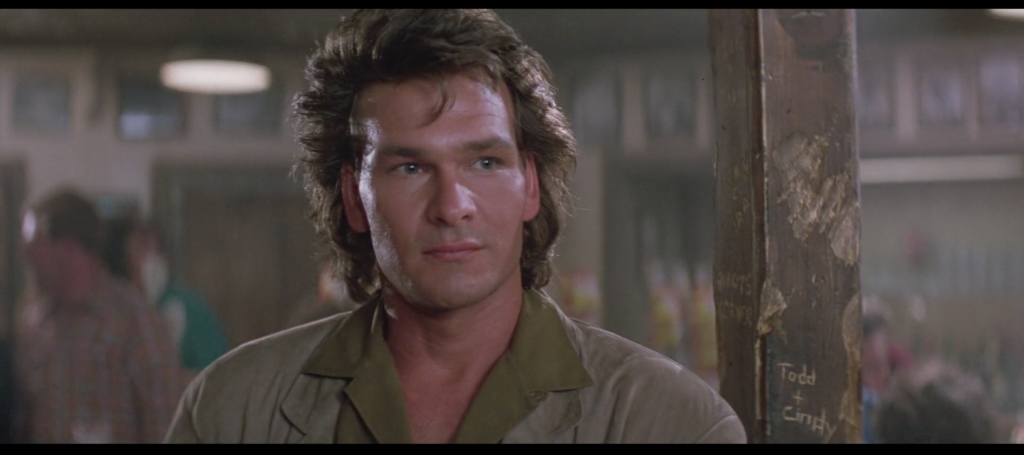Posts Tagged ‘the fellowship of the ring’
080. Dodge
March 21, 2019
If there’s anything else in the history of action cinema I’ve studied with the same open-hearted intensity I’ve applied to Road House, it’s the Tomb of Balin/Bridge of Khazad-dûm sequence from Peter Jackson’s The Fellowship of the Ring. Back in the summer of 2001, in the Before Times, I was invited by New Line Cinema in my capacity as assistant editor of the Abercrombie & Fitch Quarterly, my first real job out of college (see what I mean about the Before Times?) to watch the 20 minutes or so of footage from Jackson’s first Lord of the Rings movie that had been publicly screened, initially some weeks prior at the Cannes Film Festival. Wisely the studio had selected the film’s first real action setpiece, the slobberknocker with the orcs and the cave troll in Balin’s Tomb and the flight down the crumbling staircase afterwards. Any doubts I might have harbored about the ability of Jackson, a filmmaker whom I loved for Heavenly Creatures but wasn’t sure could tamp down his manic style for Tolkien’s world, evaporated the moment the fighting began. This was a director who understood that effective action is shaped by the environment in which it’s staged, with easily understandable physical stakes for the success and failure of each blow and maneuver, relayed through camerawork that allows the eye to parse the spatial relationships between the combatants.
What’s more, and the friend I brought along with me as my plus-one to the screening room is the one who pointed this out, Jackson understood that the key to fantasy as a genre is scale, intuiting George R.R. Martin’s much-quoted dictum that we turn to fantasy “to find the colors again,” to transcend drab reality on (paraphrasing here) the wings of Icarus rather than Southwest Airlines. Neither Jackson nor Martin (nor Tolkien, nor Benioff & Weiss for that matter) felt this meant completely detaching the material from reality; on the contrary, the punishing realism of Martin’s setting and the painstaking detail of the Weta Workshop’s worldbuilding made the truly massive scope of the landmarks and lives of Westeros and Middle-earth all the more convincing.
I’ve told this story many times now, but it was specifically one of the Moria sequence’s action beats that brought this home to me. As the Fellowship flees down those gigantic, precarious stairs, orcs begin pelting them with arrows. Legolas, the Elven archer, turns and fires back at one of the distant foes. The camera travels as if mounted on the shaft, giving us an arrow’s eye view of the cave and the evil creature on the opposite end towards whom it is racing. A cut at the moment of impact switches us to a view of the same cavern from just behind and above the orc (by now struck right between the eyes and plummeting into the abyss below), angled downward toward the Fellowship on the stairs hundreds of yards away. The arrow’s flight, and our flight along with it, describes that vast space in a way a more traditional establishing shot could not. If we’d started with that over-the-shoulder shot looking down at the Fellowship we’d have gotten the picture I suppose, but we wouldn’t have been made to feel the space, the scale, the awe.
Whether to reserve the sight of the Balrog for the eventual filmgoing public or because that sight had not yet been completed I can’t recall, but the preview cut off with our final glimpse of the Fellowship escaping the stairs. The chase across the Bridge, the standoff between Gandalf and the Balrog, Gandalf’s triumph and fall, and the Fellowship’s mournful escape had to wait until the premiere. But there’s another moment with an arrow that stuck with me then and still does today. As Aragorn, the last one out of the Mines, looks back at the chasm, the rain of arrows from the orcs, who’d given the Balrog a wide berth, resumes. Viggo Mortensen, an amazing proficient action performer for a guy who had about a week of instruction before his first on-camera swordfight compared to the rest of the cast’s extensive training camp, had clearly been instructed by Jackson to act as though he was dodging arrows that were added digitally after the fact. Like a particularly generous pro wrestler he sold the hell out of it, at one point ducking so dramatically it’s like he was avoiding some big galoot’s haymaker. The desultory choreography of the move jumps out at me because Mortensen’s Aragorn is otherwise a model of physical efficiency in his fighting style, as befits a man who’s been hunted all his life and has learned that excess movement can mean the difference from ending a fight merely exhausted and ending a fight dead. It’s taken me time to come around to it but I now recognize it as the right approach for a character who’s been momentarily poleaxed by a grief he never believed he’d experience.
Anyway, at one point during the big bar-destroying fight that breaks out in Road House when a man squeezes another man’s wife’s tits without paying to kiss them as he’d appeared to agree to do, a stray bottle comes flying in Dalton’s direction and shatters against the post next to which he’s been standing and taking in the scene, and he dodges it and resumes watching in less time than it took either of the arrows described above to do their thing. This doesn’t tell us anything about the scale of the Double Deuce, the spatial relationship between Dalton and the unseen bottle-thrower, the nature of the world in which the film takes place, the emotional state of the characters, or the approach of director Rowdy Herrington toward the material. It just tells us that Dalton is so good at dodging broken glass that it doesn’t even disturb his spit-curl. And that’s all you need to know, son.
The arrow that made me love The Lord of the Rings
June 26, 2014On my A Song of Ice and Fire tumblr boiledleather.com the other day, a reader asked me:
I’m sure that someone has asked this before, but what are your thoughts on Peter Jackson’s Lord of the Rings-adaptations? Especially compared to Game of Thrones (different medium, I know, but still).
In May of 2001 I received an invitation through my job as associate editor of the A&F Quarterly (“the lifestyle publication” of Abercrombie & Fitch) to a screening of the 20 minutes or so of footage of the then-unreleased The Fellowship of the Ring that had screened at Cannes. This was from the Mines of Moria sequence — the discovery of Balin’s tomb, the fight with the cave troll, and the flight down the stairs. It was obviously crackerjack action filmmaking, but I’ll tell you what really hit me the hardest. As the Fellowship flees down that first flight of stairs, orc arrows start raining down on them, bouncing off the stone steps. Legolas turns and returns fire, and the camera gives us an arrow’s-eye-view of its flight across the chasm and into the forehead of an orc archer. At the moment of impact the camera cuts to a shot just above and behind the orc’s shoulder as he falls from his perch into the pit below, and suddenly we can see the enormous distance we’d just traveled on the head of that arrow. Fresh from film school as I was, I was blown away by this. Peter Jackson had used the flight of the arrow to describe the space it was shot in, using its physical movement to convey a sense of scale to us that would not have been possible if he’d simply cut back and forth between the vantage points. This of course is what all action sequences in visual media ought to do — root you in an environment, use the action beats to move you around in that environment, give as many beats as possible palpable physical stakes you can grasp and contextualize immediately. It also showed that Jackson was going to use the full force of the cinematic medium to tell this story — he wasn’t just going to line up a bunch of CGI critters and throw them at one another, nor was he going to whirl and twirl haphazardly, he was going to paint the story with the camera and the editing bay like brushes. It showed that the soon-to-be-legendary attention to detail he and the Weta team paid to every prop and set and costume had a storytelling purpose as well, that a bow and arrow and a stone chasm and a hero-orc makeup job would not just look cool but help us understand where we were and what kind of world it was and why it mattered. Finally, it showed that for the first time ever, a fantasy film was actually going to capture the scale of epic fantasy, the sheer physical awe-someness of it all above and beyond the striking images that plenty of fantasy films before it had dealt in without that ability to convincingly situate them in a world as large as our imaginations. Not a single moment in the entire trilogy contradicted these initial impressions. They’re magnificent films and I love them to pieces.



